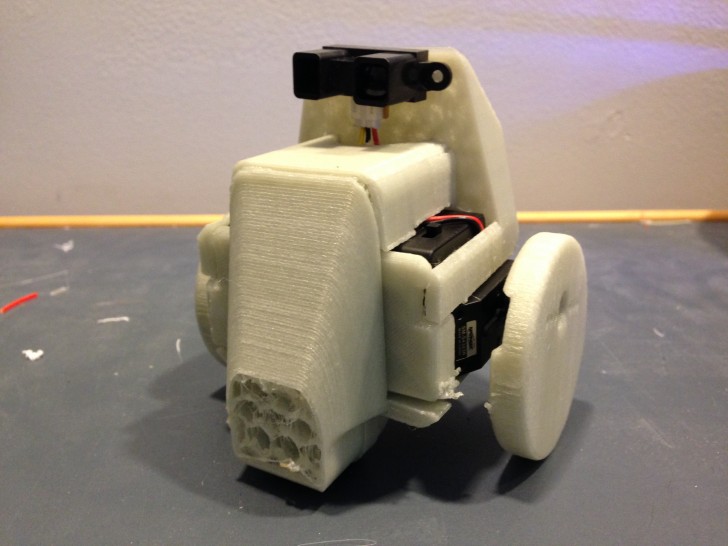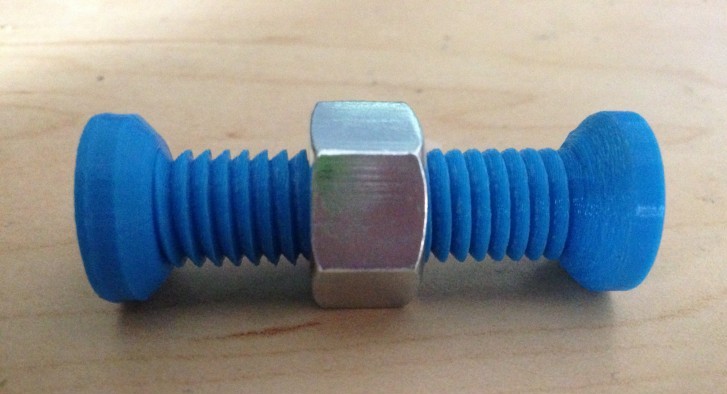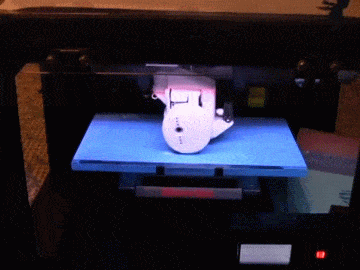3D printers, for all the jaw-dropping things they can do, cannot produce complex end-use products at the push of a button. For an object like a basic calculator, even if you 3D print the body and buttons in multiple materials in one go, you’d still have to assemble the LCD screen, the microprocessor, and the batteries within it – and these can’t be 3D printed, at least not yet. So even though multi-material, multi-color 3D printing is bringing us closer, with high-end models or prototypes and end-use metal or plastic parts, it isn’t quite all-singing, all-dancing yet. In a world where a majority of the objects we interact with or use are assemblies of integrated components, 3D printing raises more questions than answers.
And this is just what Alex Crease, a 3D printing enthusiast and student at the Olin College of Engineering, thought about in a rather fundamental way. As he points out, 3D printing is a ‘relatively hands-off manufacturing process’ and it is only after printing that we post-process, finish or modify it for assembly or end-use, if at all. It is also why manufacturers are rushing to build the next 3D printer that can print in one-go, with integrated electronics and vastly different materials, ready-to-use products hot off the build-plate. But Alex is looking at it another way.
“We don’t need to have a printer that can print an assembly with multiple parts and materials to print a multi-material object. Most of what we need is already right in front of us; a printer, and a bunch of different objects and pre-fabricated parts to play with.”
He introduces the idea of ‘Co-processing’ which he defines as ‘modifying and adjusting a 3D printed job as it is being manufactured to produce content that could not have been created easily otherwise’. The idea is to build the assembly on-the-go as it 3D prints. It requires the ability to pause the 3D print, assemble the component to be integrated into the print, and then continue printing till the object is finished. To understand what Alex has in mind, consider this impossible bolt that he made using a MakerBot Replicator 2.
He also brings perspective as to the role and application co-processing could have on production,
“Co-processing has potential because it incorporates multiple types of manufactured parts into one print job. You can combine a product’s manufacturing process with its assembly process by placing parts into a 3D print job as it is printing. You can design a robot, assemble it while it is printing, and have it walk itself off the build plate upon completion. From a manufacturing perspective, this cuts down on assembly time, as now some of the manufacturing time and assembly time have now been combined and span the time of one print job.”
For his next project, he went on to make what he claimed was his coolest 3D print. He ‘co-processed‘ a robot, integrating an Arduino Mini, two continuous rotation servo motors, a long-range Sharp IR sensor, and a battery box, that rolled off the build-plate once finished.

The housing, which includes a main body and covering piece, and the two wheels are 3D printed sequentially, as the other components are integrated.
Since the print is being paused and resumed, one of the difficulties Alex faced was ensuring build adhesion. As the plastic cools while the print is paused, it warps and this can cause problems when the print resumes.
Surfaces may not adhere as they should, points of contact may not align, and heavily warped sections risk being damaged by the extruder. So he had to make sure his 3D printed parts had low surface contact and relatively simple cross sections to make this stop-and-go printing method a smooth process.
To get the 3D printed and assembled robot to roll of the print-bed the moment the last layer was finished, he had an IR sensor fitted in. The sensor recorded the distance from the top of the printer as the build plate lowered. Once the build plate lowers to the point where the 3D print’s last layer is done, the sensor estimates the distance, the motors activate and the wheels turn, rolling the robot off the build-plate. In his attempt, the robot didn’t roll off too smoothly, but the 3D print did come alive. Although it made a slight nuisance of itself, its a problem that’s easily fixable, and more importantly, it successfully demonstrated the idea of co-processing.
Of course, with conductive filaments and more extruders, integrating the electronics into assemblies might become easier. Yet overall, the notion of introducing 3D printing directly into the flow of manufacturing an end-product is unique. Maybe it isn’t so much about expanding the capabilities of 3D printers to make everything but more about slotting it into the assembly lines for what we already make. Maybe co-processing is the most economical way of using 3D printing for production.





